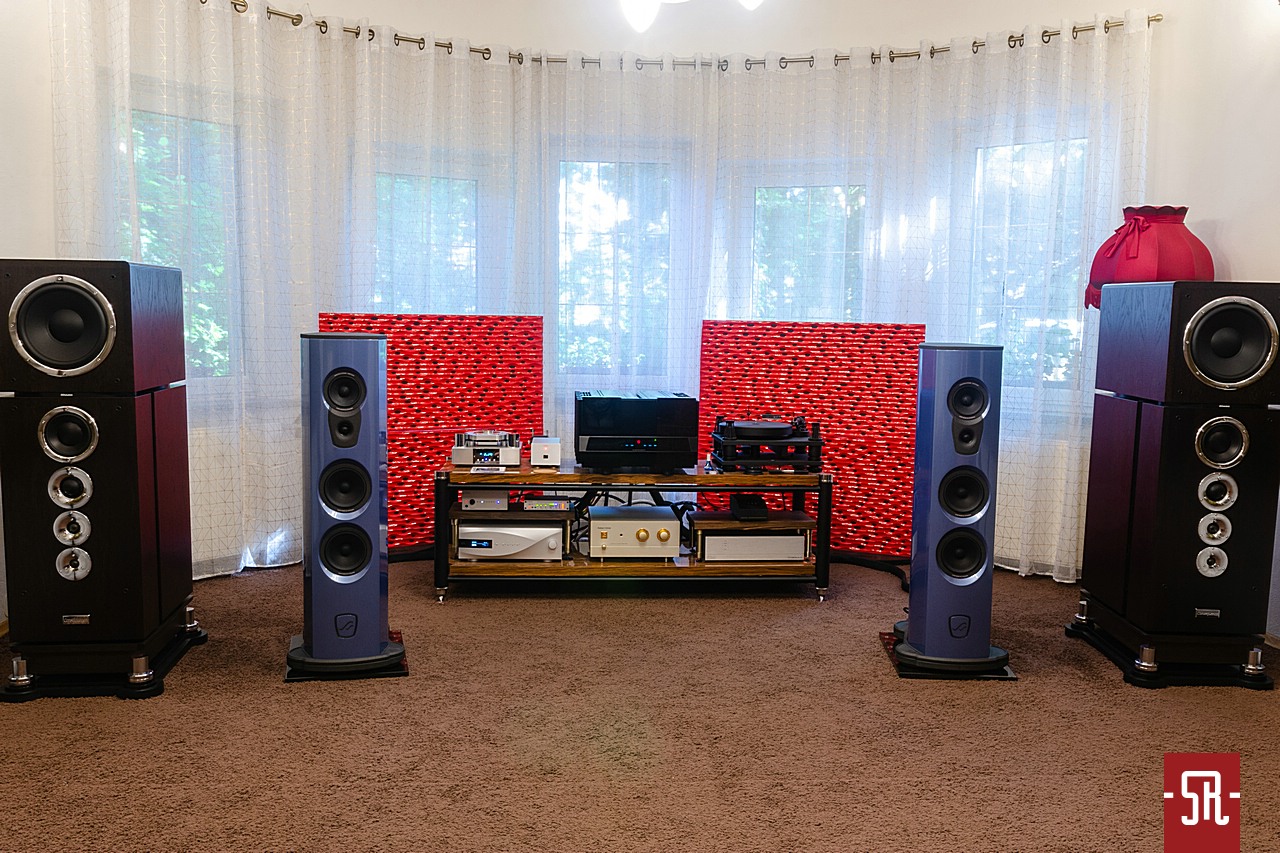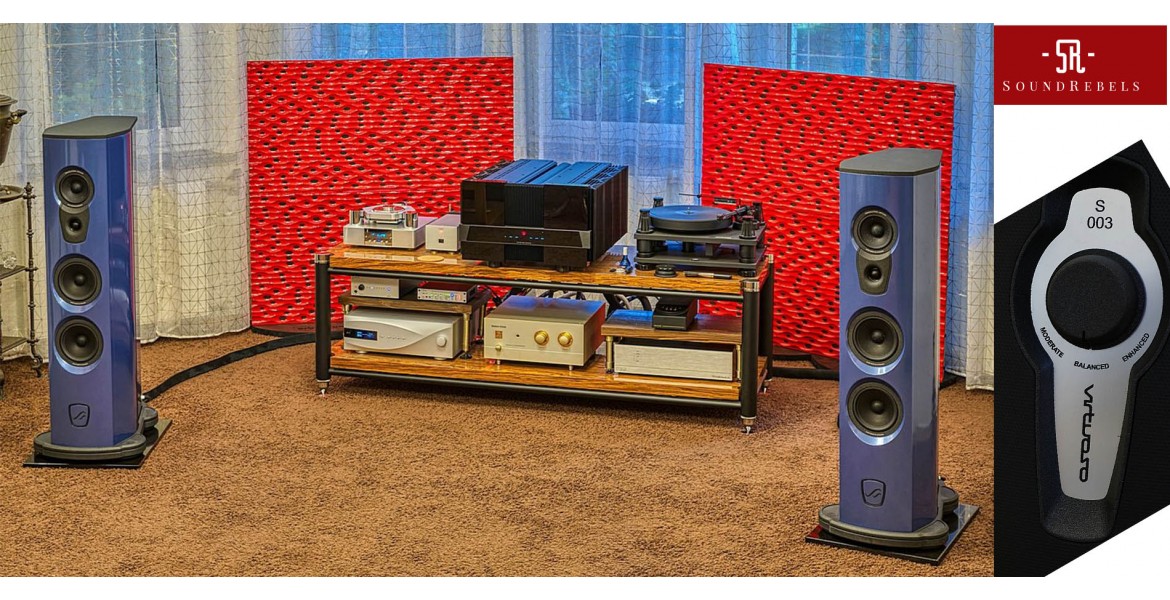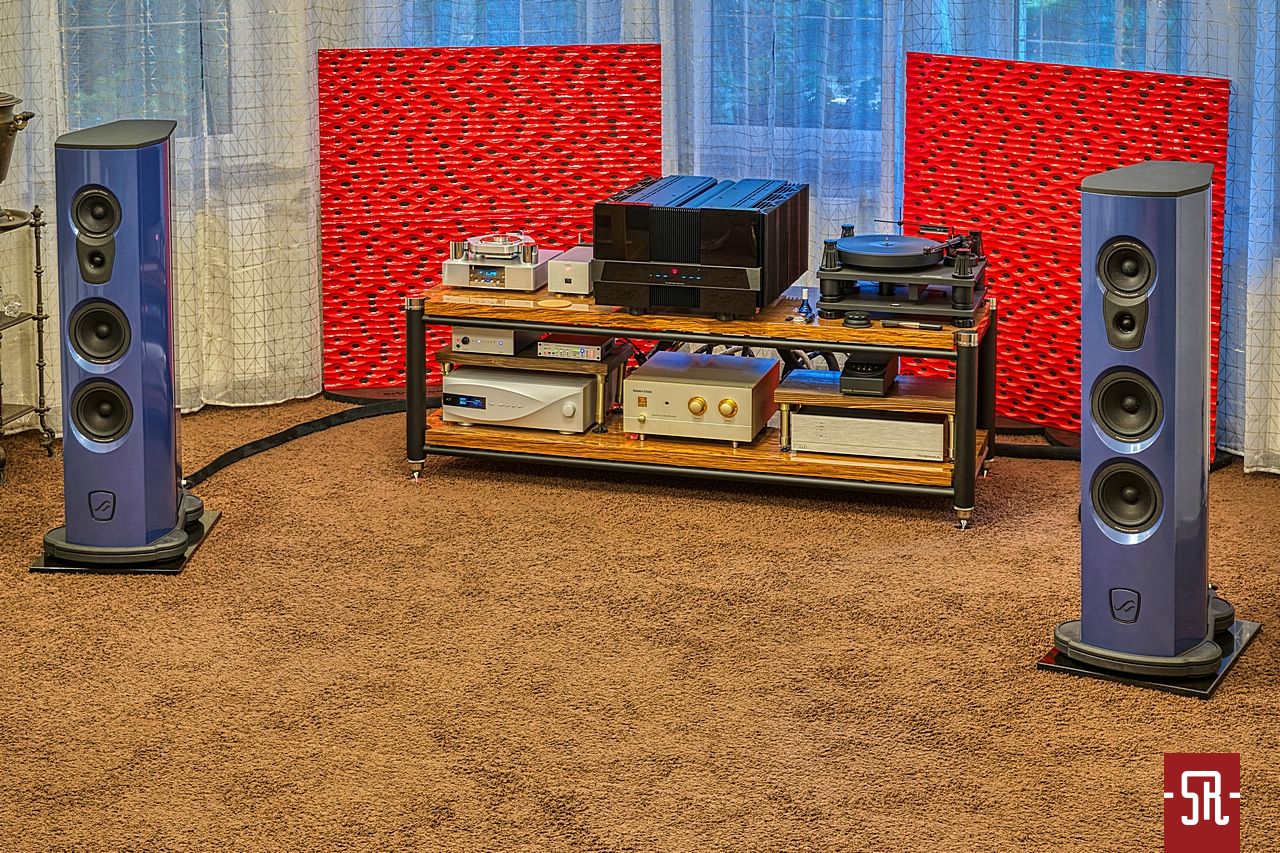
Opinion 1
We already had the pleasure of meeting the tested brand a few times before.
And despite those meetings being very pleasant, for some reason our contacts severed about five years ago. And, frankly speaking, the reason does not really matter.
What does matter however, is that the brand fares very well on the international market, what means, that it did not sleep through the mentioned five years, but used it to broaden its portfolio, and most probably, also improving the sonic abilities of the proposed products.
This is the reason, that when we received a proposition of having a look at one of the newest models, we immediately made arrangements to have them delivered to our listening room.
Taking into account our earlier encounters, we were waiting impatiently, but finally they arrived, and we can now have a closer look at the Lithuanian floor standing loudspeakers AudioSolutions Virtuoso S, which are distributed in Poland by the Sopot based Premium Sound.
The looks, and in particular the dimensions, and the multiple drivers packed in the chassis of the Lithuanian speakers suggest, that we are dealing with typical High End here. Those are 110 cm high and weighing about 50 kg, three way, floor standing speakers, here in metallic blue.
The cabinet of the Virtuoso S, in its transversal cross-section resembles a variant of a lute, what means, that each of the cabinet walls is in fact curved, what combats standing waves inside the enclosure. Interesting is the splitting of the side walls with a vertical separator, connecting the top with the oversized plinth, supporting the whole on soft feet.
The front baffle houses four, slightly recessed drivers. Looking from the bottom, the manufacturer implemented two bass drivers, above them, in a black mold, a tweeter and a midrange driver on top.
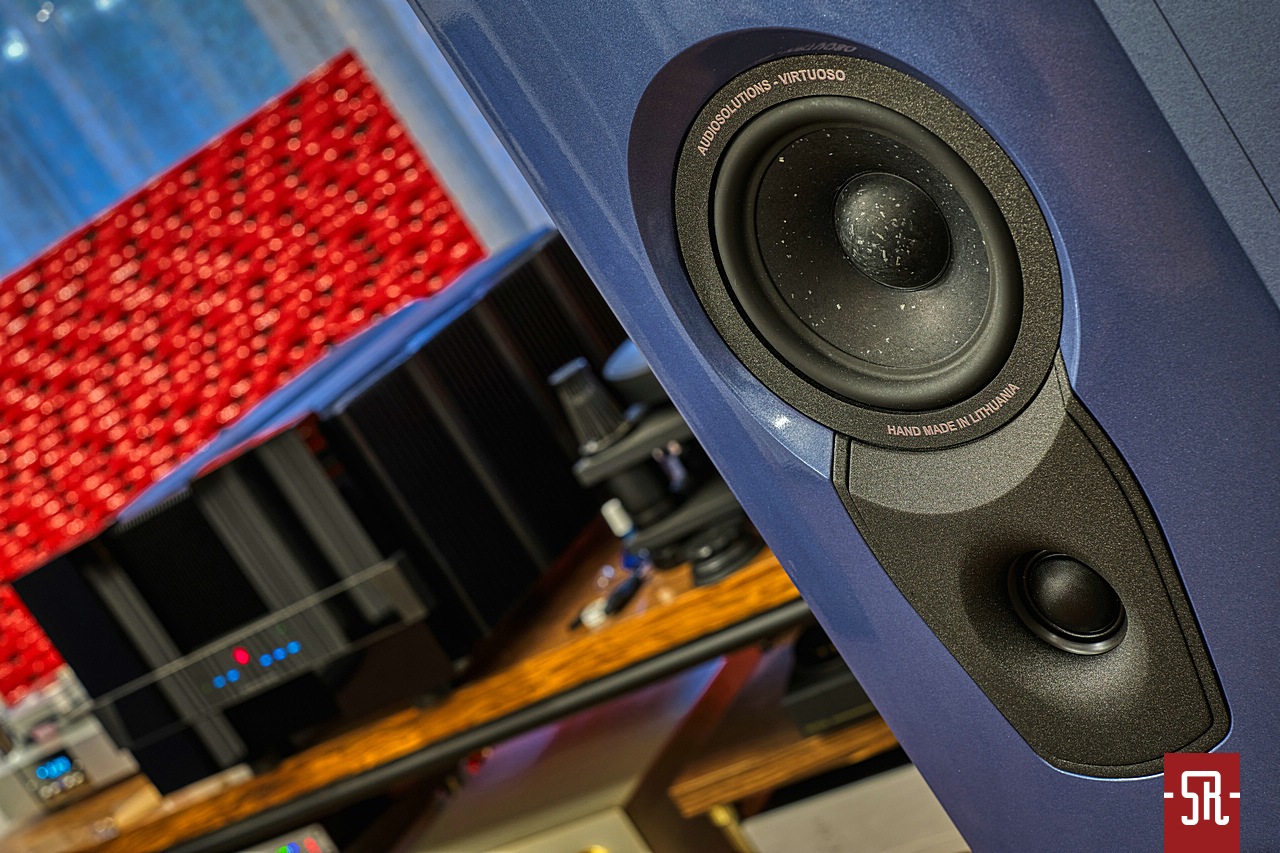
A look at the back shows, that they are quite packed too, as on the bottom we have a double wire terminal, then two bass-reflex ports and in the middle a knob, which sets the modes of the cross-over. According to the manufacturer, we have three options. The first one selects maximum clarity with a grandiose virtual stage.
The second one is dedicated to accommodate loads like rock music and similar. Finally the third one should best fit musical styles based on quietness and emotion. During the tests, where I tested all options of course, I chose the second setting, as it turned out to be most universal, of course with my stereo system.
The first very positive aspect I remembered from the test, interestingly enough, was saturated sound, with great rhythm and energetic bass.
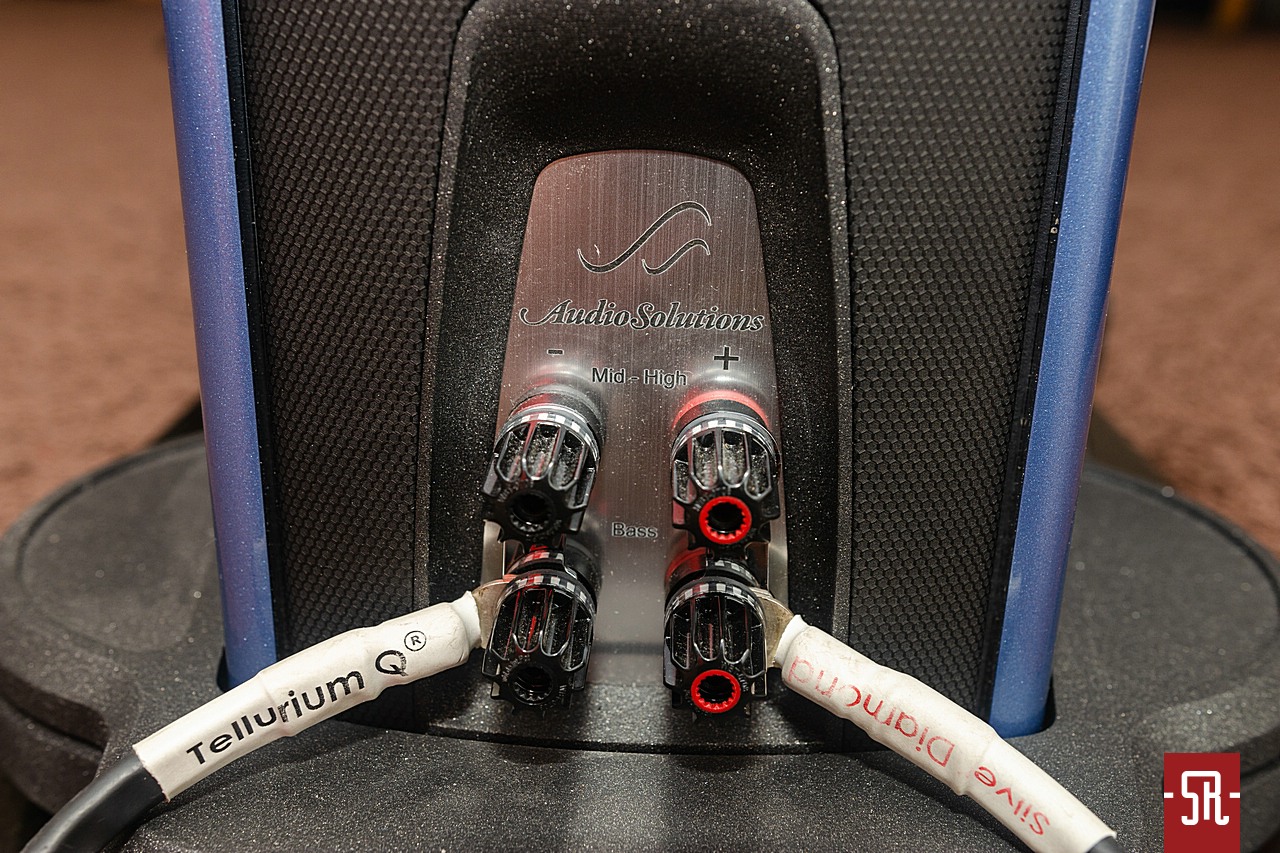
This is really the most important idea of how those speakers sound, something I always liked very much in my journey of advanced audio. Clearly, even given such approach, there should be no thickening of the phrases reaching my ears, no overburn of the sound. And I must say with joy, that the constructors of the Virtuoso S were able to avoid this hurdle easily.
Yes, the music pulsated all the time with a strong midrange and well built base, but such presentation was aided with tremendous treble.
Those were no needles and pins scavenging around detached from the rest of the sound, but slightly golden and calm, yet absolutely capable of creating a well aired musical event. And you need to remember which cross-over mode I selected – the one dedicated to high loads, with some restraints put on the upper part of the spectrum, so you can unleash more into the music with a simple turn of the knob.
Of course those are not the only assets of the tested speakers, as due to the nice, contoured body of the sound, the generated virtual sound sources were easily defined, what translated into a very readable 3D spectacle on a wide and deep stage. This was fantastically shown by the disc “White Night” by Stephan Micus.
This is a splendid mix of very niche instruments, yet very talkative in their sound – duduk and kalimba. Hearing the very saturated, very “damp”, wooden wind instrument in a conversation with the colorfully vibrating kalimba, I could not stop listening and I was inhaling the fullness of long decays of the mentioned instruments, that I did not notice, when this quite exotic, in terms of presented music, album ended. I must confess, that I did not expect this result of Lithuanian craftsmanship to perform so well, so I was really surprised.
So I had no choice than confront the tested speakers with heavier music, in the form of “Machine Head” by Deep Purple. In this case the result was similar to the one I got using more soul soothing music. Strong guitar riffs, fullness of the vocals of the frontman, and everything backed with strong drums and percussion showed, that even with recordings of mediocre quality, a system which is even only slightly musical, may bring a lot of joy to the listener.
Of course compared to speakers emphasizing on attack and speed, the event in my room was slightly less expressive, but assure you, only slightly, yet with tons of pleasure. For me this was bulls-eye, because I prefer to listen to music from that era in this version, rather than the tiring, shrill version caused by bad mastering. It was still emotional, but more physiological, smoother and juicier, something that should have been done by the sound engineer and was not. Finally a few sentences about electronic music. In this case I used “Exciter” by Depeche Mode to test the Lithuanian speakers.
This confrontation, to be frank, was half on half, depending on what your preferences are. On one hand, the support of bass and midrange phenomenally fulfilled the expectations of the musicians in terms of low notes, murmurs and almost seismic passages. Also the vocals gain on that, being very readable, and thus well-articulated.
But when I looked closer at the top registers, sometimes, not every time, I missed the ruthlessness of destroying my ears. On one hand that was nice, as do not like brutal attacks on my hearing, but in absolute terms, it was less aggressive. Of course you could re-balance the whole into perceiving real pain and forget about what I am talking, using an appropriate set of cables. But I am trying to show you, how those speakers fare with different kinds of music, using one configuration, so I could not go around mentioning that.
But again, you should filter my observations through your preferences and the electronics you own, as I have tuned my set with a slight emphasis on saturation, while a neutral system, might place the accents in different spots, what would nullify the nuances observed by me.
As you can see, the AudioSolutions Virtuoso S from Lithuania showed, that they are no stranger to musicality.
This of course had its impact on how the upper notes were created in aggressive musical endeavors. But I remind you, for the tested speakers this was not an issue, as the manufacturer implemented a knob on their backs, which allows to change the modes of the cross-over from sharp, through balanced to a golden honey one. This makes the tested heroes capable of fitting into even very demanding systems.
This leaves me no choice, than to a very honest recommendation to all music lovers, especially those on a road crossing, to test them out in their own rooms and systems.
If it will be a success, the selectable modes of the cross-over will make you resist further changes for years.
And what should you expect more? J
acek Pazio
Opinion 2
Our today’s publication is the best proof, that human memory is very unreliable and time moves at incredible speed, a speed you cannot really keep up without losing your breath.
Am I exaggerating? Not really, as I was quite certain, that we keep an eye on things happening, and something like loudspeakers AudioSolutions, designed by Gediminas Gaidelis, are regular guests in our reviews. Yet already last year’s Audio Video Show proved, that our idea is, delicately speaking, not really conform with reality.
I am of course talking about the presentation prepared by Premium Sound and 4HiFi on the PGE Narodowy Arena, where Virtuoso M sounded very well with the Shanling A600 monoblocks and a Line Magnetic LM-512CA preamp. That presentation resulted in our declaration, that we would like to test those speakers, so we immediately started to arrange logistics. So everything should be fine now.
But when the emotions related to unboxing the slightly smaller Virtuoso S faded away and we looked at the calendar, it turned out, that from the last review of the Lithuanian speakers almost five years have passed. Yes, yes, precisely in December 2015 we publish our observations gathered during the listening session of the monumental Vantage.
So without further ado, and not prolonging the absence of the AudioSolutions in our listening room, I am inviting you to read on.Already the budget Rhapsody 80 and the larger Rhapsody 130 showed, that for Gediminas Gaidelis, the owner and main designer of the brand, the idea of loudspeaker does not equal the “boring”, rectangular shape, that dominates the market.
This was further strengthened with the Vantage, where Mr. Gaidelis could try whatever he wanted, while the accountants did not interfere. It is similar with the Virtuoso S, which strain the wallet less, and are smaller than the big predecessors, but still catch the eye with their shape and bold color schemes. So let us start with what we can see, the colors.
As standard we can order pearl white, silver grey, zinc grey and black, but true choice starts with custom varnishes like British Racing Green, Glacier blue, gold, Lemon and the supplied Ice blue, with the top, plinth and a few inserts finished in grey polyurethane varnish with coal power, which results in a rough, clearly palpable structure.
The shape of the cabinets brings to mind a cubistic variant of commonly used lute.
But it is worth to notice, that what we see is only the exterior shell, as the Virtuoso have a proprietary solution, “a box in a box”, something like a loudspeaker variant of the Russian matryoshka, where one cabinet is placed over another. The internal one is made from HDF and has lots of reinforcements, while the external one is made from classic MDF.
The whole construct gains stiffness, and due to the sandwich structure, it eliminates parasite resonances, which can impair the function of the drivers.
Talking about the drivers – on the front baffle we will find a 3cm silk dome tweeter placed in a small tube (waveguide), a 13.2cm midrange and two 16.5cm woofers with cellulose pulp membranes. Even more interesting is the narrow back of the speakers, where besides the double WBT Nextgen loudspeaker terminals, which allow bi-wiring or bi-amping, and double bass-reflex ports, we will see a non-conventional solution, a massive, three position knob, which selects the mode of sound. Ergonomically this is a much more convenient solution than the “phone central” of the Vantage.
The listener can select between the Balanced setting – emphasizing on cleanness and spaciousness, Moderate – dedicated to long-distance listening and Enhanced, which underlines the details. Additionally, instead of simple jumper cables or filters, the manufacturer decided to enhance appropriate sections of the cross-over.
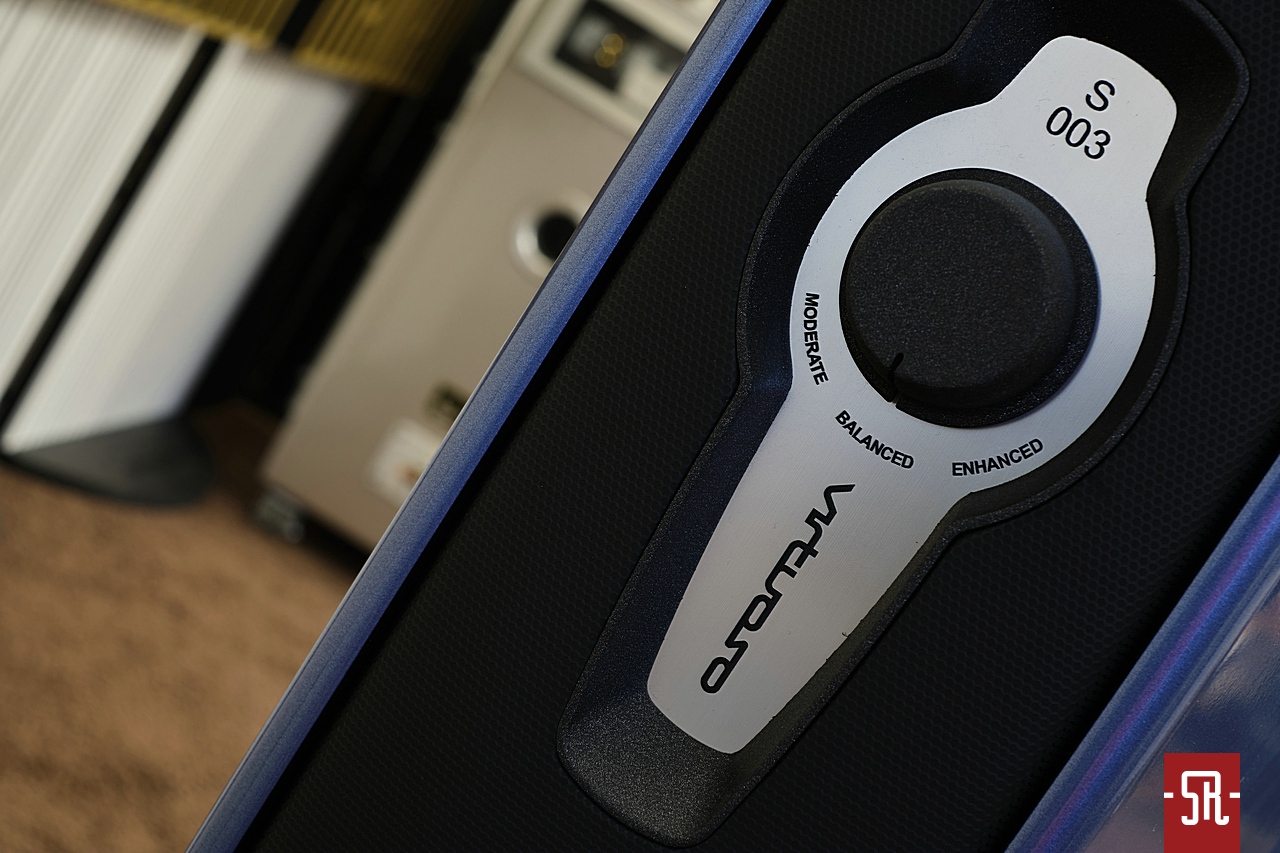
This has quite obvious implications, as despite seeming ease to drive (91.5dB/4Ohm) powerful solid state power amplifiers are needed to drive them properly. And one more small, but very defining item.
The manufacturer really cares about their own products, and you can see that from the really armored enclosure, the Virtuoso are delivered in. Instead of cardboard boxes, we get massive trunks from plywood and chipboard, which can easily withstand the trouble of handling them by courier companies.
This is the reason, that when you decide for the Virtuoso, you should be prepared – having a fully loaded electric screwdriver handy, as you will need to unbolt all side walls and someone to help you carry, each 50kg speaker has additional 30kg of packaging material on it.
Taught by experience gained during the test of the Vantage I treated the configuration part very seriously, so without any experiments most of the listening tests were conducted using the Gryphon Mephisto, an amplifier, which you certainly cannot blame for having low power of current.
As the time needed for burning-in was handled by Jacek, during the test I have noticed no changes in the sound of the Lithuanian speakers. Now regarding their sound, I can say, that the Virtuoso steer around the stereotypes attributed to large speakers. Usually, when looking at quite large speakers, having 1.13m height and more than half a meter of depth, you expect adequate, rather spectacular, Hollywood-like presentation – with lots of bass.
Yet the AudioSolutions are playing in a very linear and refined way. Initially you can have the impression, that the scale of the sound offered are maybe not small, but not living to our expectations. Only after a while we realize, that everything is OK, and it is just us, who need to get our heads around and stop looking at them from the perspective of enlarged sound sources and blown out sound stage, as this is completely wrong. Here everything was accurate, exactly as it should.
This can be easily seen with small, chamber ensembles, where all departures from the known master are obvious and indisputable. Let us take as an example the extremely moody album “Soulmotion” by Natasa Mirkovic and Nenad Vasilic, only vocals and double bass.
Too little too boring? Not at all, but let me warn you, this is not elevator music, that is filling annoying silence or is just a background.
Absolutely not. Here the silence is playing, it is a very important element of the artistry, being not only the adhesive, gluing together the vocalist and musician picking the strings of the “overgrown violin”, but in fact the third musician. Mirkovic is standing close to us, her voice is smooth and warm, but incredibly strong, not by being forced, but by natural predisposition and great schooling, including opera. In absolute categories we should add, that it is a bit boosted emotionally and more natural than neutral, but I like this kind of aesthetics best, so I will not qualify it as any flaw, but rather a characteristic of the Lithuanian loudspeakers.
On the other hand the double bass enchants with deep passages and equally “analog” timbre, with slightly thickened contours of the individual sounds, however without losing their definition or readability. The mentioned way of sounding does not interfere with listening to much more complicated and effect loaded positions.
The dark, thick and very disturbing in soundtrack of “Underworld” by Paul Haslinger sounded very convincing. Electronic scrapings, creaks and truly infrasound murmurs built the multilayered background very suggestively, brilliantly corresponding with modifying vocals (“Red Tape”) never falling into boring monotony.
And here I will allow myself a small digression caused by the, quite obvious, dissonance between what we see and what we hear. It is about the fact, that the Virtuoso look very modern, if not to say futuristic, in the eye catching colors, belonging to the Hi-Tech camp, while in terms of sound, they are much closer to the “paper” classics, which place the hedonistic pleasure of listening far above laboratory precision.
This does not mean that everything is put on the midrange, but its assets are underlined and it is homogenously and very seamlessly connected to both ends of the sound spectrum. You cannot complain about any shortcoming in the bass and treble range, what was very clearly shown by the album “Walk the Sky” by Alter Bridge, which, delicately speaking, is not very quiet.
Guitar riffs pierced the air as they should without any veiling, the cymbals also never lacked any shine. With a lot of satisfaction I noted, that the granularity and offensiveness, which irritated any listener usually, evolved in the direction of gold plated smoothness and palpability. The difference was seemingly small, but after long hours of listening, it could not be overestimated.
I will forgo the fact, that due to my musical preferences I used a very limited choice of discs I could call “audiophile”, so I very often explored the “Moderate” profile of the speakers, which made the speakers concentrate mostly on proper reproduction of dynamic and emotional aspects of the recordings and not on trying to show how bad a job the sound engineers did.
Please believe me, that even the thirty years old “Rust in Peace” by Megadeth could claim having something in the form of juiciness and euphonia, assets, which are usually not expected from this disc. Magic? Rather an ability of the speakers to certain repertoire and the expectation of the listener.
Additionally this is a wonderful proposition for all those, who have obsessive compulsive disorder, and audiophilia nervosa, already after a few weeks from buying new gear, or talking straight, they start immediately searching again. Having the Virtuoso we have a true 3 in 1. Because having one pair of speakers we have three similar, yet someway different, points of view.
And that without juggling with power, antivibration accessories, cables and all that, what causes all those, who usually laugh at such things, to begin ranting. I do not know how you see it, but for me this is bulls-eye and mating water with fire.
Orthodox purists will chose one setting, that fits best their system and beloved repertoire, forgetting about it later on, while the rest of the population will just turn it according to their needs, situation and whim. I am not sure, if the manufacturer and the Polish distributor will like what I am going to write now, but … when looking for high-end loudspeakers for years, with what I mean such speakers, which will not annoy me once the emotions and first delight fade away, I would suggest to start exploring the AudioSolutions portfolio from the Virtuoso S, and not the Vantage.
Please note however, that I am basing this on my experience from before the “5th anniversary” version, but with aggressive, based on drive and mad tempos music, the currently tested loudspeakers were much closer to my personal taste and expectations.
The “small” Virtuoso have musicality and sound in a noble way, but attached to a potent amplifier, they have no restraints in bashing us into our listening seat, or drill our head with a fierce riff, when it is needed.
Still they allow us to ease down with our beloved music and that without discrediting less well recorded material, or without trying to catch our attention at all cost.
Marcin Olszewski
System used in this test: – CD transport” CEC TL 0 3.0 – DAC: dCS Vivaldi DAC 2.0 – Reference clock: Mutec REF 10 – Reclocker: Mutec MC-3+USB – Shunyata Research Sigma CLOCK – Shunyata Sigma NR – Preamplifier: Robert Koda Takumi K-15 – Power amplifier: Gryphon Audio Mephisto Stereo – Loudspeakers: Dynaudio Consequence – Speaker Cables: Tellurium Q Silver Diamond – IC RCA: Hijri „Million”, Vermouth Audio Reference – IC XLR: Tellurium Q Silver Diamond – Digital IC: Harmonix HS 102 – Power cables: Harmonix X-DC 350M2R Improved Version, Furutech NanoFlux NCF Furutech DPS-4 + FI-E50 NCF(R)/ FI-50(R), Hijiri Nagomi; Vermouth Audio Reference Power Cord – Table: SOLID BASE VI – Accessories: Harmonix TU 505EX MK II, Stillpoints ULTRA SS, Stillpoints ULTRA MINI, antivibration platform by SOLID TECH, Harmonix AC Enacom Improved for 100-240V, Harmonix Room Tuning Mini Disk RFA-80i – Power distribution board: POWER BASE HIGH END – Acoustic treatments by Artnovion Analog stage: Drive: SME 30/2 Arm: SME V Cartridge: MIYAJIMA MADAKE Phonostage: RCM THERIAA Step-up: Thrax Trajan
Technical details
Frequency response (in-room environment): 26-30000 Hz
Sensitivity: 91.5 dB @ 2.83V 1m
Impedance: nominal 4,0 Ω
Crossover frequency: 500 Hz; 7000 Hz
Nominal power handling: 130 W rms
Maximum unclipped power handling: 260 W
Dimensions (HxWxD): 1130mm x 391mm x 547mm; 44.4 x 15.4 x 21.5in
Weight: 50 kg/100 lbs each
Audio Solutions Virtuoso S -Buy Now
